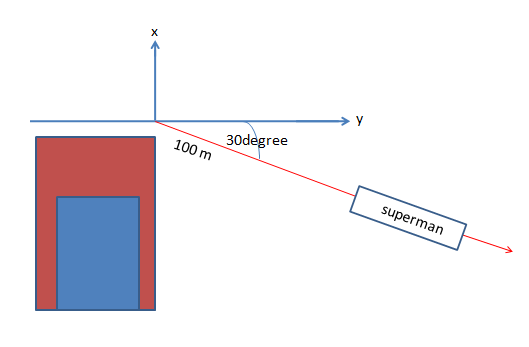
Find the horizontal and vertical components of the \[100m\] displacement of a superhero who flies from the top of a tall building following the path shown in the above figure:


Answer
504.9k+ views
Hint: A vector can be divided into two components along two perpendicular axes, those are called the rectangular components. Since the displacement is a vector quantity it also has the resolution along two axes. The values of the two components are cosine and sine of the angle multiplied with the magnitude of the vector. Note that, here the angle is the angle between the vector and the horizontal component.
Complete step by step answer:
In a two-dimensional coordinate system, any vector is broken into x -component and y -component. for instance, the vector \[V\] is broken into \[2\] elements, \[{V_x}\] and \[{V_y}\] . If the angle between the vector and its x -component be \[\theta \]
\[{V_x} = V\cos \theta \]
\[{V_y} = V\sin \theta \]

Here, displacement is a vector quantity. Let, the displacement vector is . given that, the angle between the vector and its x -component be \[\theta = 30^\circ \]
vector \[S\] is broken into two elements, \[{S_x}\] and \[{S_y}\].
\[{S_x} = S\cos \theta \]and \[{S_y} = S\sin \theta \]
Given, the magnitude of , \[S = 100\]
So, \[{S_x} = S\cos \theta = 100\cos 30^\circ \]
\[ \Rightarrow {S_x} = 100 \times \dfrac{{\sqrt 3 }}{2}\]
\[ \Rightarrow {S_x} = 50\sqrt 3 \]
And, \[{S_y} = S\sin \theta = {\text{100}}\sin 30^\circ \]
\[ \Rightarrow {S_y} = 100 \times \dfrac{1}{2}\]
\[ \Rightarrow {S_y} = 50\]
Hence, the horizontal and vertical components of the \[100m\] displacement will be \[ \Rightarrow {S_x} = 50\sqrt 3 \] and \[ \Rightarrow {S_y} = 50\]respectively.
Note: If we want to break the vector \[V\] along this vector itself i.e along the vector \[V\], the angle between the vector and its x -component will be \[\theta = 0^\circ \],
Such as, \[{V_x} = V\cos 0^\circ = 0\]
And, the vertical component will be \[{V_y} = V\sin 0^\circ = 0\]
From these we can conclude:
The value of the component of a vector along this particular vector will be the same as the magnitude of the vector.
There will be no vertical component of the vector in this case.
Complete step by step answer:
In a two-dimensional coordinate system, any vector is broken into x -component and y -component. for instance, the vector \[V\] is broken into \[2\] elements, \[{V_x}\] and \[{V_y}\] . If the angle between the vector and its x -component be \[\theta \]
\[{V_x} = V\cos \theta \]
\[{V_y} = V\sin \theta \]

Here, displacement is a vector quantity. Let, the displacement vector is . given that, the angle between the vector and its x -component be \[\theta = 30^\circ \]
vector \[S\] is broken into two elements, \[{S_x}\] and \[{S_y}\].
\[{S_x} = S\cos \theta \]and \[{S_y} = S\sin \theta \]
Given, the magnitude of , \[S = 100\]
So, \[{S_x} = S\cos \theta = 100\cos 30^\circ \]
\[ \Rightarrow {S_x} = 100 \times \dfrac{{\sqrt 3 }}{2}\]
\[ \Rightarrow {S_x} = 50\sqrt 3 \]
And, \[{S_y} = S\sin \theta = {\text{100}}\sin 30^\circ \]
\[ \Rightarrow {S_y} = 100 \times \dfrac{1}{2}\]
\[ \Rightarrow {S_y} = 50\]
Hence, the horizontal and vertical components of the \[100m\] displacement will be \[ \Rightarrow {S_x} = 50\sqrt 3 \] and \[ \Rightarrow {S_y} = 50\]respectively.
Note: If we want to break the vector \[V\] along this vector itself i.e along the vector \[V\], the angle between the vector and its x -component will be \[\theta = 0^\circ \],
Such as, \[{V_x} = V\cos 0^\circ = 0\]
And, the vertical component will be \[{V_y} = V\sin 0^\circ = 0\]
From these we can conclude:
The value of the component of a vector along this particular vector will be the same as the magnitude of the vector.
There will be no vertical component of the vector in this case.
Recently Updated Pages
Why are manures considered better than fertilizers class 11 biology CBSE

Find the coordinates of the midpoint of the line segment class 11 maths CBSE

Distinguish between static friction limiting friction class 11 physics CBSE

The Chairman of the constituent Assembly was A Jawaharlal class 11 social science CBSE

The first National Commission on Labour NCL submitted class 11 social science CBSE

Number of all subshell of n + l 7 is A 4 B 5 C 6 D class 11 chemistry CBSE

Trending doubts
What is meant by exothermic and endothermic reactions class 11 chemistry CBSE

10 examples of friction in our daily life

One Metric ton is equal to kg A 10000 B 1000 C 100 class 11 physics CBSE

1 Quintal is equal to a 110 kg b 10 kg c 100kg d 1000 class 11 physics CBSE

Difference Between Prokaryotic Cells and Eukaryotic Cells

What are Quantum numbers Explain the quantum number class 11 chemistry CBSE




